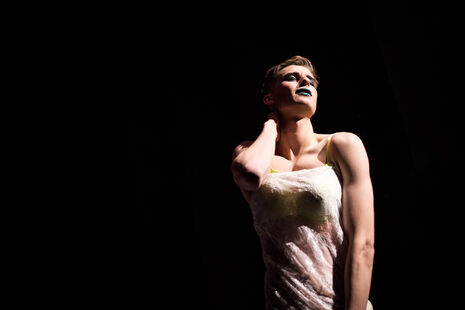Manon/Sandra
Nathaniel Hess is enraptured by this profound and unusual play

Manon/Sandra is an ingenious play of polarities and paradoxes, and this slick production never fails to complement the brilliance of the script. The audience is presented with two stark, almost diametrically opposed characters: austere, fanatical Manon, with her stiflingly personal relationship with God, and Sandra, a male transvestite, proud to the point of narcissism and obsessed with sex. The two never engage with each other on stage, and it is only by the sheer force of the juxtaposition that the audience is compelled to draw surprising comparisons.
The dominant set of binaries, apparently lapidary but challenged across the course of the play, is consistently palpable, in the layout of the furniture on the stage, in the costume and make-up, and particularly in the gestures and voices of the actors. We see Manon, all in black, clutching enormous clinking rosary beads, her furniture austere save for a statue of the Virgin Mary, and, on the other side of the stage, Sandra, heavily made-up, his tiny white dress complementing the creamy hue of his shaven legs, his furniture a mirror and a chaise-longue spread with a flamboyant white coverlet; two extremes are placed before us, and straight away, from the reversal of the traditional schema whereby white represents purity and black a blackness of spirit, we are compelled to question our assumptions about which of the two is the more perverse. And later we might wonder whether the two people, the two aesthetics and worldviews placed before our eyes are really so far from being parallels. Manon attempts to make up for her lack of self worth through devotion to her rosary beads, her statuette of the Virgin Mary, and chiefly through her fanatical devotion to God - things independent of the self through which she may be affirmed. Is Sandra, really behaving so differently? Does he, we wonder, compensate for the same lack of self worth through narcissism, through his devotion to the image of himself in the mirror and his alienated cock, thereby making a counter-intuitive attempt to escape the self by flight into the ego? Thus the play yields its intellectual thrills.
There was, therefore, an extraordinary onus upon the actors to represent this complex psychology, and they pulled it off marvellously. Clara Strandhoj’s portrayal of Manon was full of self-abnegatory gestures of supplication, with trembling and nervousness in her voice. But the script emphasized the ambiguity of this behaviour: the mystic, like the lover, lives in constant self-abasement, and waits upon obscure signs from an absent and unknowable other. Strandhoj assuredly rose to these demands, and her final quasi-orgasmic monologue was a veritable coup de théâtre. Jamie Webb’s Sandra was equally superb; his flamboyance and outspokenness, and his gestures floating camply through the air, created such a foil to the dour mood of Manon’s monologues that it sent the audience into frequent fits of laughter.
An interesting challenge arises from the form of interwoven monologues: who are the characters addressing? Are they addressing the audience, themselves, or God? The answer must be that to varying degrees they are addressing all three, and this gives an opportunity to mingle confession and loneliness with exhibitionism and narcissism, blurring these conventional distinctions. One got the impression that the director (Laura Batey) had really grasped this ambiguity by the horns and ran with it, and this was one of the reasons for the successful coherence of the whole.
A fascinating play, with a production deeply commendable on every level, it cannot be sufficiently stressed that anyone at a loose or even vaguely unknottable end over the next few days should make their way to the ADC to see it.
 News / Cambridge bus strikes continue into new year16 January 2026
News / Cambridge bus strikes continue into new year16 January 2026 News / Uni members slam ‘totalitarian’ recommendation to stop vet course 15 January 2026
News / Uni members slam ‘totalitarian’ recommendation to stop vet course 15 January 2026 Science / Why smart students keep failing to quit smoking15 January 2026
Science / Why smart students keep failing to quit smoking15 January 2026 Interviews / The Cambridge Cupid: what’s the secret to a great date?14 January 2026
Interviews / The Cambridge Cupid: what’s the secret to a great date?14 January 2026 News / Cambridge local elections to go ahead in May despite local government reorganisation16 January 2026
News / Cambridge local elections to go ahead in May despite local government reorganisation16 January 2026








